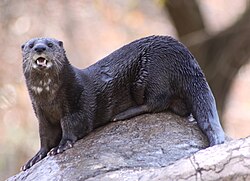ノドブチカワウソ
ノドブチカワウソ(Hydrictis maculicollis)は、哺乳綱食肉目イタチ科に分類されるカワウソ。本種のみでノドブチカワウソ属Hydrictisを構成する[4]。サハラ砂漠以南のアフリカに分布し、おもに魚類を食べる[6]。
| ノドブチカワウソ | ||||||||||||||||||||||||||||||
|---|---|---|---|---|---|---|---|---|---|---|---|---|---|---|---|---|---|---|---|---|---|---|---|---|---|---|---|---|---|---|
 ノドブチカワウソ Hydrictis maculicollis
| ||||||||||||||||||||||||||||||
| 保全状況評価[1] | ||||||||||||||||||||||||||||||
| NEAR THREATENED (IUCN Red List Ver.3.1 (2001)) 
| ||||||||||||||||||||||||||||||
| 分類 | ||||||||||||||||||||||||||||||
| ||||||||||||||||||||||||||||||
| 学名 | ||||||||||||||||||||||||||||||
| Hydrictis maculicollis (Lichtenstein, 1835)[4] | ||||||||||||||||||||||||||||||
| シノニム[5] | ||||||||||||||||||||||||||||||
|
Lutra maculicollis Lichtenstein, 1835 | ||||||||||||||||||||||||||||||
| 和名 | ||||||||||||||||||||||||||||||
| ノドブチカワウソ[6] | ||||||||||||||||||||||||||||||
| 英名 | ||||||||||||||||||||||||||||||
| Spotted-necked otter[5] | ||||||||||||||||||||||||||||||
 分布
|
形態
編集比較的小型のカワウソで、オスは体長71-76cm、体重5.7-6.5kg、メスは体長57-61cm、体重3.0-4.7kg。尾は長く筋肉質で、オス・メスとも長さ39-44cm[7][8]。他の多くのカワウソ同様、体は滑らかで、水かきのある足で泳ぐことができる[9]。
個体によってかなりのばらつきがあるが、毛皮は通常、赤~チョコレート色味がかった褐色で、胸と喉にクリーム色または白色の斑点がある。頭は幅広く、口吻は短く、耳は小さく丸みを帯びており、無毛の鼻を持つ。歯は魚を食べるのに適応しており、大きく鋭い上顎犬歯、湾曲した下顎犬歯、鋭い裂肉歯がある。あごの構造も魚食に適応しており、下顎窩は下顎の顆に完全にはまり込んでおり、下顎は横に動くことがなく、魚を捕らえ、保持しやすくなっている[9]。
分類
編集食性などの生態からカワウソ属の特徴を持つとされており[6]、以前はカワウソ属に含める説もあった[5]。一方で陰茎骨の形態ではツメナシカワウソ属の特徴を持つとされていた[6]。のちにカワウソ属の他種とは区別されるようになり、独立した属として分類されるようになった[4]。遺伝子やゲノムに基づく分子系統解析でも、旧世界に分布するカワウソ類の中では初期に分岐した系統であることが支持されている[10][11]。
最大で7亜種に分ける説が提唱されたこともあったが、現在ではそれらは亜種というよりも個体変異の範疇に属すと考えられている[5]。
脚注
編集- ^ Reed-Smith, J., Jacques, H. & Somers, M.J. 2021. Hydrictis maculicollis. The IUCN Red List of Threatened Species 2021: e.T12420A164578992. https://doi.org/10.2305/IUCN.UK.2021-3.RLTS.T12420A164578992.en. Accessed on 03 October 2022.
- ^ CITES, “Appendices I, II and III,” valid from 22 June 2022, Convention on International Trade in Endangered Species of Wild Fauna and Flora, Available at: https://cites.org/eng. Accessed 03/10/2022.
- ^ 川田伸一郎・岩佐真宏・福井大・新宅勇太・天野雅男・下稲葉さやか・樽創・姉崎智子・横畑泰志 「世界哺乳類標準和名目録」『哺乳類科学』第58巻 別冊、日本哺乳類学会、2018年、1-53頁。
- ^ a b c d W. Christopher Wozencraft, “Order Carnivora,” In: Don E. Wilson & DeeAnn M. Reeder (eds.), Mammal Species of the World (3rd ed.), Johns Hopkins University Press, 2005, Pages 532-628.
- ^ a b c d Serge Larivière, “Lutra maculicollis,” Mammalian Species, No. 712, American Society of Mammalogists, 2002, Pages 1–6.
- ^ a b c d 斉藤勝・伊東員義・細田孝久・西木秀人「イタチ科の分類」、今泉吉典監修『世界の動物 分類と飼育 2(食肉目)』東京動物園協会、1991年、42-46頁。
- ^ BBC Wild Facts (2011).
- ^ Arkive.org Archived 2011-09-06 at the Wayback Machine. (2011).
- ^ a b Larivière, S. (2002). “Lutra maculicollis”. Mammalian Species 712: Number 712: pp. 1–6. doi:10.1644/1545-1410(2002)712<0001:LM>2.0.CO;2.
- ^ Klaus-Peter Koepfli, Kerry A Deere, Graham J Slater, Colleen Begg, Keith Begg, Lon Grassman, Mauro Lucherini, Geraldine Veron & Robert K Wayne (2008). “Multigene phylogeny of the Mustelidae: Resolving relationships, tempo and biogeographic history of a mammalian adaptive radiation”. BMC Biology 6: 10. doi:10.1186/1741-7007-6-10.
- ^ Vera de Ferran, Henrique Vieira Figueiró, Fernanda de Jesus Trindade, Oliver Smith, Mikkel-Holger S. Sinding, Cristine S. Trinca, Gabriele Zenato Lazzari, Géraldine Veron, Juliana A. Vianna, Filippo Barbanera, Sergei Kliver, Natalia Serdyukova, Tatiana Bulyonkova, Oliver A. Ryder, M. Thomas P. Gilbert, Klaus-Peter Koepfli & Eduardo Eizirik (2022). “Phylogenomics of the world’s otters”. Current Biology 32 (16): 3650-3658. doi:10.1016/j.cub.2022.06.036.